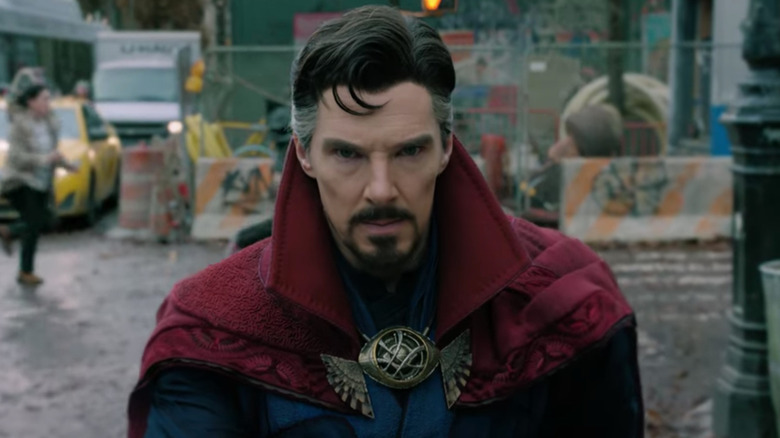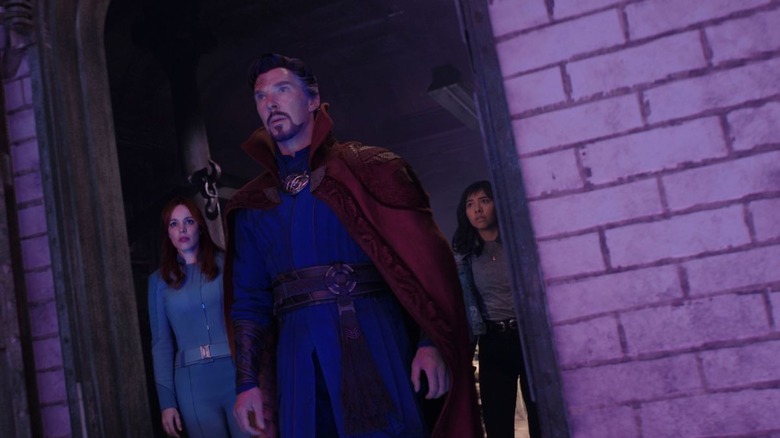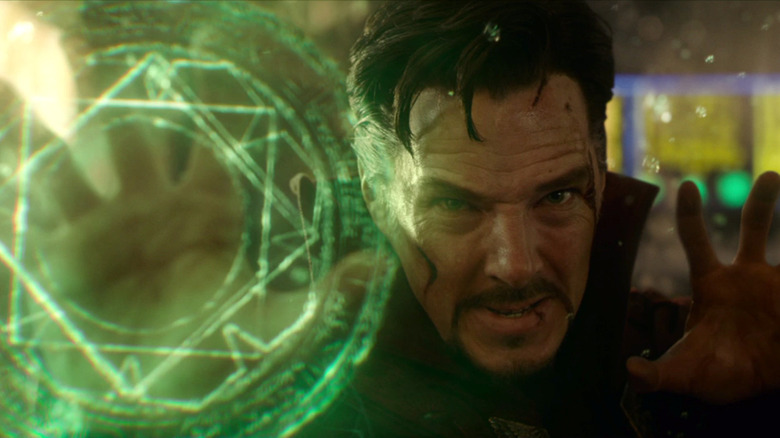Why The Doctor Strange In The Multiverse Of Madness Mid-Credits Scene Undercuts The Ending
Warning: This article will openly discuss spoilers for ending and the mid-credits scene from Sam Raimi's "Doctor Strange in the Multiverse of Madness." If you haven't yet seen the film and wish for it to remain unspoiled, read no further.
To follow Doctor Stephen Strange (Benedict Cumberbatch) is to witness a man's downfall. At the beginning of the 2016 film "Doctor Strange," Stephen is an arrogant blowhard with no magical powers. By the end of that movie, he's become a soldier in an ongoing mystical war between wizards and demons, adopting a rather mercenary attitude about the requirement of extreme measures in desperate situations. His devotion to that extreme would have him splitting open the very fabric of reality before advising Spider-Man that he could, instead, have a talk with a school board official.
By the end of "Doctor Strange in the Multiverse of Madness," the good doctor has learned an alternate version of himself accidentally murdered trillions of people, and had been executed for his crimes. He also will have committed acts of necromancy, allied with the souls of the damned, and read evil spells from The Darkhold, an ancient book of corrupt magic. Doctor Strange has committed so many questionable acts throughout his various film appearances, it's hard not to argue that he's on the road to becoming a supervillain.
This is made rather explicit by the mid-credits cookie in "Multiverse of Madness" which depicts a now-evil Doctor Strange kind of taking his corruption in stride.
He's evil now...
The finale of "Doctor Strange in the Multiverse of Madness" is a confrontation between the title character and the Scarlet Witch (Elizabeth Olsen) who seeks to suck out the dimension-hopping superpowers from the young America Chavez (Xochitl Gomez) in order to be with her parallel universe sons again. The Witch had already recently experienced another uptick in her powers, and she has become corrupted as a result, meaning that her gaining additional multidimensional powers point to a grave risk for all life on Earth(s). Doctor Strange must stop her, but he was left stranded in another dimension fighting an evil version of himself. Once his "evil" self is destroyed, Doctor Strange immediately grabs The Darkhold, sets up a Satanic ritual with a circle of candles, and broadcasts his consciousness into the dead body of another of his doppelgängers.
During the fight between the Scarlet Witch and Zombie Strange — who, by the way, also has taken control of an army of damned souls — America implores that he kill her and suck out her powers instead, as she would rather Doctor Strange have them than the Scarlet Witch. Fortunately, he is able to resist the temptation of this power, and instead encourages America to use her powers to free herself.
America manages to do so, using her abilities to force the Scarlet Witch to see the error of her ways, and Doctor Strange is returned to his native dimension — but the worse for wear. After all the dodgy decisions Stephen Strange made over the course of his movie, he has become infected with the Darkhold's evil influence. The last shot of the movie is Stephen falling to his knees in pain, a third eye opening on his forehead. This was a mark worn by his "evil" self from earlier in the movie, indicating that Doctor Strange is being punished for dabbling too much with the dark arts. It raises the stakes and is certainly a fitting ending for a character who was, as audiences witnessed, far too cavalier with black magic.
But then the mid-credits scene happens...
...And he's okay with that.
As with all films in the MCU, "Multiverse of Madness" features a cute little post-script in the middle of its credits, a time often reserved for debuting new characters that will appear in future films, or bringing back older characters to have a fun, little moment of crossover interaction. Often there will be a hint as to what kind of story we have to look forward to, and Marvel has been pretty good about paying off all the setups.
In "Multiverse's" post-credits scene, Doctor Strange is walking down the street of New York, seemingly unfazed by the ending audiences just witnessed of him displaying his angst at having been corrupted by bad magic. A portal spontaneously opens in front of him, and Charlize Theron (as Marvel Comics character Clea) steps out, asking the doctor to join her in an as-yet undefined war mission. Doctor Strange opens his evil third eye and expresses enthusiasm about joining her in battle.
But wasn't Doctor Strange supposed to be suffering right now? Wasn't the opening of his third eye meant to denote that he had gone too far this time? That he was now infected with the stink of wickedness, and has to contend with the fact that he now may be a demonic entity? Wasn't his monkeying with the Darkhold supposed to have ... consequences? After multiple films of Doctor Strange making bad decisions and allowing himself to commit increasingly extreme acts in times of desperation, Doctor Strange was suppose to finally be facing the music. One can only possess corpses and split reality open so many times before one must pay the piper.
The fact that Doctor Strange — the next day? That same morning? — immediately assimilated the evil into his body undercuts the justice he was supposed to face. The mid-credits scene is not played for chills or with a hint of irony, but — in a very Sam Raimi fashion — is played for comedic badassery. There are no consequences for the doctor. He had nothing taken from him. He's back on his feet and buying croissants from Starbucks within minutes of realizing his soul has been corrupted.
It looks like Doctor Strange now has the (im)moral license to do whatever he wants and — like a parallel version of himself — will be considered a hero no matter how evil he becomes. Had the film left Doctor Strange in a place of pain, the poetic irony would have been complete. Instead, that irony was replaced by an action quip and a fun cameo. It's certainly disappointing.


